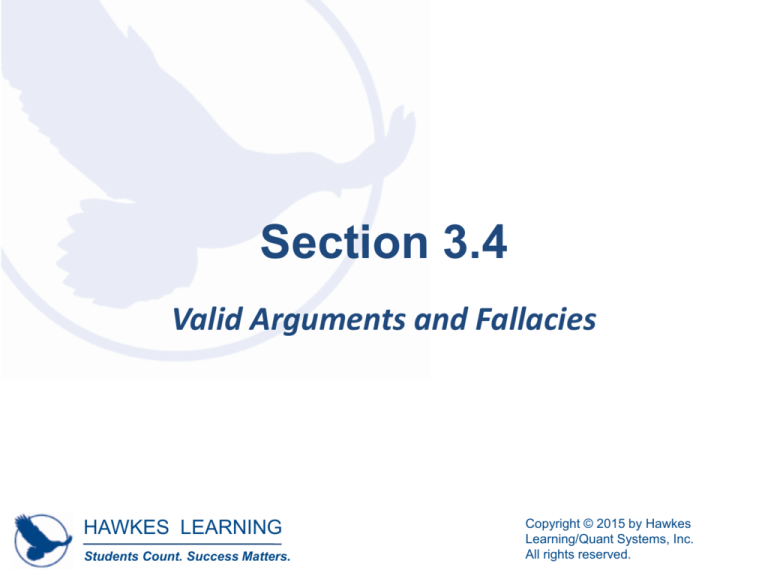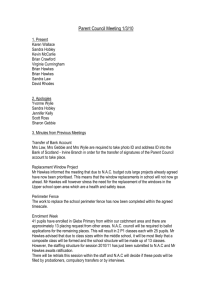
Section 3.4
Valid Arguments and Fallacies
HAWKES LEARNING
Students Count. Success Matters.
Copyright © 2015 by Hawkes
Learning/Quant Systems, Inc.
All rights reserved.
Objectives
o Identify common fallacies in arguments
HAWKES LEARNING
Students Count. Success Matters.
Copyright © 2015 by Hawkes
Learning/Quant Systems, Inc.
All rights reserved.
Argument
Argument
An argument consists of a series of logical statements.
HAWKES LEARNING
Students Count. Success Matters.
Copyright © 2015 by Hawkes
Learning/Quant Systems, Inc.
All rights reserved.
Premise
Premise
A premise is a statement at the beginning of an
argument used to support the conclusion.
HAWKES LEARNING
Students Count. Success Matters.
Copyright © 2015 by Hawkes
Learning/Quant Systems, Inc.
All rights reserved.
Argument, Premise and Conclusion
Conclusion
A conclusion is the ending statement of an argument.
HAWKES LEARNING
Students Count. Success Matters.
Copyright © 2015 by Hawkes
Learning/Quant Systems, Inc.
All rights reserved.
Premise and Conclusion Indicators
The terms premise and conclusion are relative terms.
They infer a position in an argument. No statement
taken out of the context of the argument can be either
a premise or a conclusion on its own; they work
together. There are particular words that often indicate
conclusions or premises are to follow.
HAWKES LEARNING
Students Count. Success Matters.
Copyright © 2015 by Hawkes
Learning/Quant Systems, Inc.
All rights reserved.
Premise and Conclusion Indicators
Table 1: Premise and Conclusion Indicators
Premise Indicators
Conclusion Indicators
as
as indicated by
because
due to the fact that
for
for the reason that
given that
if
in as much as
in that
may be concluded from
may be inferred from
seeing that
since
the reason that
accordingly
consequently
entails that
hence
implies that
it must be that
it follows that
so
then
therefore
thus
we may conclude that
we may infer that
whence
Wherefore
HAWKES LEARNING
Students Count. Success Matters.
Copyright © 2015 by Hawkes
Learning/Quant Systems, Inc.
All rights reserved.
Skill Check #1
Skill Check #1
Identify the premise and conclusion in each of the
following.
a. Our technology will deliver a better product, so you
will have fewer complaints.
b. Your employees will feel better and be more
productive if you build in communal break times to
the work day.
HAWKES LEARNING
Students Count. Success Matters.
Copyright © 2015 by Hawkes
Learning/Quant Systems, Inc.
All rights reserved.
Skill Check #1
Answer: a. Premise: our technology will deliver a
better product; Conclusion: you will have
fewer complaints
b. Premise: you build in communal break
times to the work day; Conclusion: your
employees will feel better and be more
productive
HAWKES LEARNING
Students Count. Success Matters.
Copyright © 2015 by Hawkes
Learning/Quant Systems, Inc.
All rights reserved.
Inductive Reasoning
Inductive Reasoning
Inductive reasoning is a line of argument that takes
specific examples as its premise and then draws a
general conclusion from these.
HAWKES LEARNING
Students Count. Success Matters.
Copyright © 2015 by Hawkes
Learning/Quant Systems, Inc.
All rights reserved.
Deductive Reasoning
Deductive Reasoning
Deductive reasoning uses statements that are
commonly accepted as facts to make a case for a
certain conclusion.
HAWKES LEARNING
Students Count. Success Matters.
Copyright © 2015 by Hawkes
Learning/Quant Systems, Inc.
All rights reserved.
Valid Arguments
Valid Argument
A valid argument is a deductive argument where the
conclusion is guaranteed from the premises.
HAWKES LEARNING
Students Count. Success Matters.
Copyright © 2015 by Hawkes
Learning/Quant Systems, Inc.
All rights reserved.
Examples of Valid Arguments
Here are some examples of valid arguments.
1. All men are mortal.
Socrates is a man.
Therefore, Socrates is mortal.
2. Taylor Swift makes great music.
Her new CD was just released. It must be great!
3. Cutting out sweets from your diet makes you lose weight.
He hasn’t eaten sweets in months, so he must be losing
weight.
HAWKES LEARNING
Students Count. Success Matters.
Copyright © 2015 by Hawkes
Learning/Quant Systems, Inc.
All rights reserved.
Example 1: Determining the Validity of an
Argument
Show that the following argument is valid.
All men are mortal.
Socrates is a man.
Therefore, Socrates is mortal.
Solution
The first line of the argument, “All men are mortal,” can
be read as the conditional statement “if one is a man,
then he is mortal,” which can be expressed with
notation as p ⇒ q. This means that we have the
following simple statements.
HAWKES LEARNING
Students Count. Success Matters.
Copyright © 2015 by Hawkes
Learning/Quant Systems, Inc.
All rights reserved.
Example 1: Determining the Validity of an
Argument (cont.)
p: One is a man.
q: One is mortal.
If we assume p ⇒ q is true, we can consider the case
for Socrates. Since we know that Socrates is a man, we
know that Socrates satisfies p. Consider the truth table
for p ⇒ q.
HAWKES LEARNING
Students Count. Success Matters.
Copyright © 2015 by Hawkes
Learning/Quant Systems, Inc.
All rights reserved.
Example 1: Determining the Validity of an
Argument (cont.)
Table 3 : Truth Table
p
q
p⇒q
T
T
T
T
F
F
F
T
T
F
F
T
We are assuming that both p and p ⇒ q are true.
According to the truth table, if these two statements
are true, then q must also be true. Consequently, we
conclude that q is true of Socrates, and so Socrates
must indeed be mortal.
HAWKES LEARNING
Students Count. Success Matters.
Copyright © 2015 by Hawkes
Learning/Quant Systems, Inc.
All rights reserved.
Skill Check #2
Skill Check #2
Show that arguments 2. and 3. are valid by using the
same method given in Example 1.
HAWKES LEARNING
Students Count. Success Matters.
Copyright © 2015 by Hawkes
Learning/Quant Systems, Inc.
All rights reserved.
Skill Check #2
Answer:
Argument 2: The first line can be expressed as p ⇒ q (If
it was made by Taylor Swift, then it is good music).
Since we know that Taylor Swift made her new CD, p is
satisfied. If we take p ⇒ q to be true, the truth table of
p ⇒ q ensures that when p is true, q is true.
Consequently, we can conclude that q is true of Taylor
Swift’s new album, and that it is great.
HAWKES LEARNING
Students Count. Success Matters.
Copyright © 2015 by Hawkes
Learning/Quant Systems, Inc.
All rights reserved.
Skill Check #2
Argument 3: The first line can be expressed as p ⇒ q (If
you cut sweets out of your diet, then you will lose
weight). Since we know that he has not eaten any
sweets (that is, he has cut out sweets), p is satisfied. If
we take p ⇒ q to be true, the truth table of p ⇒ q
ensures that when p is true, q is true. Consequently, we
can conclude that q is also true, and that he is losing
weight.
HAWKES LEARNING
Students Count. Success Matters.
Copyright © 2015 by Hawkes
Learning/Quant Systems, Inc.
All rights reserved.
Invalid Argument
Invalid Argument
An invalid argument is an argument where the
conclusion is not always guaranteed from the premises.
HAWKES LEARNING
Students Count. Success Matters.
Copyright © 2015 by Hawkes
Learning/Quant Systems, Inc.
All rights reserved.
Example 2: Determining the Validity of an
Argument
Let’s change argument 3. from the valid examples given
previously.
The original argument was
Cutting out sweets makes you lose weight. He hasn’t
eaten sweets in months, so he must be losing weight.
Switch the last two portions so that the argument
becomes
Cutting out sweets makes you lose weight. He’s losing
weight, so he must be cutting out sweets.
Show that the modified argument is invalid.
HAWKES LEARNING
Students Count. Success Matters.
Copyright © 2015 by Hawkes
Learning/Quant Systems, Inc.
All rights reserved.
Example 2: Determining the Validity of an
Argument (cont.)
Solution
Despite the fact that we often hear people say things
like this, the argument is invalid because the conclusion
(although it might be true) does not necessarily follow
from the premises stated. Let’s see why the conclusion
does not follow directly from the premises.
Identifying the premises and conclusion is always a
good place to start. In this case, it’s easy to spot the
conclusion because it follows “so” in the argument. The
conclusion is “he must be cutting out sweets.” Thus,
“he is losing weight” must be the premise.
HAWKES LEARNING
Students Count. Success Matters.
Copyright © 2015 by Hawkes
Learning/Quant Systems, Inc.
All rights reserved.
Example 2: Determining the Validity of an
Argument (cont.)
Let a and b be the following.
a: He is cutting out sweets.
b: He is losing weight.
You can think of the first part of the new argument as
“if you cut out sweets, then you lose weight.” This can
be expressed symbolically as a ⇒ b.
Assume a ⇒ b is true. The argument also asserts b is
true; he is losing weight. Next, we consult the truth
table for a ⇒ b to find the rows where both are true.
HAWKES LEARNING
Students Count. Success Matters.
Copyright © 2015 by Hawkes
Learning/Quant Systems, Inc.
All rights reserved.
Example 2: Determining the Validity of an
Argument (cont.)
Table 4 : Truth Table
a
b
a⇒b
T
T
T
T
F
F
F
T
T
F
F
T
Unlike our previous example, notice that there are two
combinations where both a ⇒ b and b are true: the
first and third rows.
HAWKES LEARNING
Students Count. Success Matters.
Copyright © 2015 by Hawkes
Learning/Quant Systems, Inc.
All rights reserved.
Example 2: Determining the Validity of an
Argument (cont.)
The first row has a true value for statement a and the
third row has a false value for statement a. Since there
is more than one possible truth value for statement a
when both a ⇒ b and b are true, we cannot conclude
that a is in fact true always. It does not follow logically
from the truth table. The weight loss might be a result
of some dietary restriction, exercise, or any number of
things. So this argument is invalid, even if the
conclusion is true.
HAWKES LEARNING
Students Count. Success Matters.
Copyright © 2015 by Hawkes
Learning/Quant Systems, Inc.
All rights reserved.
Skill Check #3
Skill Check #3
Consider whether the following is a valid argument.
All organisms with wings can fly. Since penguins have
wings, they must be able to fly.
HAWKES LEARNING
Students Count. Success Matters.
Copyright © 2015 by Hawkes
Learning/Quant Systems, Inc.
All rights reserved.
Skill Check #3
Answer: If we represent “the organism has wings” as p
and “the organism can fly” as q, then the first sentence
can be expressed as p ⇒ q. Since we know that
penguins do have wings, p is true of penguins. If we
take p ⇒ q to be true, the truth table of p ⇒ q ensures
that when p is true, q is true. Consequently, we can
conclude that q is true of penguins, and that they can
fly. Of course, this conclusion is not true. However,
because we assume the first conditional statement to
be true, and because our premise p is true of penguins,
this argument is logically valid.
HAWKES LEARNING
Students Count. Success Matters.
Copyright © 2015 by Hawkes
Learning/Quant Systems, Inc.
All rights reserved.
Sound Argument
Sound Argument
A sound argument is a valid argument using true
premises.
HAWKES LEARNING
Students Count. Success Matters.
Copyright © 2015 by Hawkes
Learning/Quant Systems, Inc.
All rights reserved.
Example 3: Determining Sound Arguments
Use a truth table to show that the following is a sound
argument.
If the President of the United States is unable to carry
out his or her constitutional role, then the Vice
President becomes the President of the United States. In
November 1963, President John F. Kennedy was fatally
shot. Therefore, without an election, Lyndon Johnson
became President of the United States.
HAWKES LEARNING
Students Count. Success Matters.
Copyright © 2015 by Hawkes
Learning/Quant Systems, Inc.
All rights reserved.
Example 3: Determining Sound Arguments
(cont.)
Solution
Begin by identifying the simple statements within the
compound statement.
p: The President of the United States is unable to
carry out his or her constitutional role
q: The Vice President becomes the President of the
United States.
The truth table for a conditional compound statement
is given in Table 5.
HAWKES LEARNING
Students Count. Success Matters.
Copyright © 2015 by Hawkes
Learning/Quant Systems, Inc.
All rights reserved.
Example 3: Determining Sound Arguments
(cont.)
Table 5 : Truth Table
p
q
p⇒q
T
T
T
T
F
F
F
T
T
F
F
T
You can see that the implication is true on the first,
third, and fourth lines. For a sound argument, we must
start with a true statement.
HAWKES LEARNING
Students Count. Success Matters.
Copyright © 2015 by Hawkes
Learning/Quant Systems, Inc.
All rights reserved.
Example 3: Determining Sound Arguments
(cont.)
Therefore, we’ll only consider the first two rows of the
table. We are told that in 1963, President
John F. Kennedy was fatally shot. In other words,
statement p is true. We also are told that statement q is
true in this argument because the Vice President at the
time, Lyndon Johnson, became President of the United
States. From the truth table, we know that given
statements p and q, which are true, the implication
p ⇒ q is also true. So we know that this argument is
both valid and sound.
HAWKES LEARNING
Students Count. Success Matters.
Copyright © 2015 by Hawkes
Learning/Quant Systems, Inc.
All rights reserved.
Example 4: Determining Sound Arguments
Determine if the following argument is sound.
We’ll go skiing this weekend if it snows at least 2
inches, and if we go skiing I’ll get some new boots. It
snowed 3 inches, so I must have new boots!
Solution
Let’s begin by identifying the simple statements within
the compound statement. We can write our statements
symbolically as follows.
HAWKES LEARNING
Students Count. Success Matters.
Copyright © 2015 by Hawkes
Learning/Quant Systems, Inc.
All rights reserved.
Example 4: Determining Sound Arguments
(cont.)
p: It snows at least 2 inches.
q: We go skiing.
r: I get new boots.
This argument is actually a double implication.
Ultimately, we want to show that p ⇒ r, by showing
that p ⇒ q and q ⇒ r. The truth table for this
compound implication is given in Table 6.
HAWKES LEARNING
Students Count. Success Matters.
Copyright © 2015 by Hawkes
Learning/Quant Systems, Inc.
All rights reserved.
Example 4: Determining Sound Arguments
(cont.)
Table 6: Truth Table
p
q
r
p⇒q
q⇒r
p⇒r
T
T
T
T
T
T
T
T
F
T
F
F
T
F
T
F
T
T
T
F
F
F
T
F
F
T
T
T
T
T
F
T
F
T
F
T
F
F
T
T
T
T
F
F
F
T
T
T
HAWKES LEARNING
Students Count. Success Matters.
Copyright © 2015 by Hawkes
Learning/Quant Systems, Inc.
All rights reserved.
Example 4: Determining Sound Arguments
(cont.)
We begin with the premise that it snowed 3 inches,
which ensures the truth of p. We know from the truth
table for implications that if we have a true p and a true
p ⇒ q, we can conclude q, that we do indeed go skiing.
Then going one more step, it also allows us to combine
this new conclusion, q, with q ⇒ r, to conclude r and
ensure that I get new boots. Therefore the argument is
sound.
HAWKES LEARNING
Students Count. Success Matters.
Copyright © 2015 by Hawkes
Learning/Quant Systems, Inc.
All rights reserved.
Skill Check #4
Skill Check #4
Use a truth table to show that the following is a sound
argument.
Speeding is a crime. I occasionally drive over the speed
limit. I am a criminal.
HAWKES LEARNING
Students Count. Success Matters.
Copyright © 2015 by Hawkes
Learning/Quant Systems, Inc.
All rights reserved.
Skill Check #4
Answer: Speeding is a crime can be expressed as
p ⇒ q, where
p: One drives above the speed limit.
q: One commits a crime. Speeding is a crime can be
expressed as p ⇒ q, and the truth table is as follows.
Truth Table
HAWKES LEARNING
Students Count. Success Matters.
p
q
p⇒q
T
T
T
T
F
F
F
T
T
F
F
T
Copyright © 2015 by Hawkes
Learning/Quant Systems, Inc.
All rights reserved.
Skill Check #4
For a sound argument, we must start with a true
statement. Therefore, we’ll only consider the first two
rows of the table. We are told that “I occasionally drive
over the speed limit.” In other words, statement p is
true. We also are told that statement q is true in this
argument because “I am a criminal.” From the truth
table, we know that given true statements p and q, the
implication p ⇒ q is also true. So we know that this
argument is both valid and sound.
HAWKES LEARNING
Students Count. Success Matters.
Copyright © 2015 by Hawkes
Learning/Quant Systems, Inc.
All rights reserved.
Fallacy
Fallacy
A fallacy is an error in reasoning that leads to an invalid
argument.
HAWKES LEARNING
Students Count. Success Matters.
Copyright © 2015 by Hawkes
Learning/Quant Systems, Inc.
All rights reserved.
Common Fallacies
1. Post Hoc, Ergo Propter Hoc (After This, Therefore Because of
This)
2. Dicto Simpliciter (Hasty Generalization)
3. Ad Hominem (Personal Attack)
4. Petitio Principii (Circular Reasoning)
5. Non Sequitur (It Does Not Follow)
6. Straw Man (Exaggerated or Distorted View of the Opponent)
7. False Dilemma (Illusion of Limited Choice)
8. Argumentum ad Populum (Appeal to the People)
HAWKES LEARNING
Students Count. Success Matters.
Copyright © 2015 by Hawkes
Learning/Quant Systems, Inc.
All rights reserved.
Example 5: Identifying Fallacies
Identify the type of fallacy used in each of the following
statements.
a: If public spending is not reduced, our economy will
collapse.
b: Heather just had a new fuel pump put in her car.
Forty-eight hours later, her car won’t start.
Heather’s father thinks the mechanic must not have
installed the fuel pump correctly.
HAWKES LEARNING
Students Count. Success Matters.
Copyright © 2015 by Hawkes
Learning/Quant Systems, Inc.
All rights reserved.
Example 5: Identifying Fallacies (cont.)
Solution
a: False dilemma; it is possible that both can be true at
the same time, that is, the economy can be strong
and public spending remain the same.
b: Post hoc, ergo propter hoc; there are many other
things that could cause Heather’s car to not start,
including a lack of fuel!
HAWKES LEARNING
Students Count. Success Matters.
Copyright © 2015 by Hawkes
Learning/Quant Systems, Inc.
All rights reserved.
Skill Check #5
Skill Check #5
Name the fallacy in the following statement: Chloë
drives an expensive car. She must have money to spare!
Answer: Non sequitur
HAWKES LEARNING
Students Count. Success Matters.
Copyright © 2015 by Hawkes
Learning/Quant Systems, Inc.
All rights reserved.
Summary of Fallacies
Table 7: Summary of Fallacies
Name
(Latin)
Name
(Translated)
Description
Post Hoc,
Ergo Propter
Hoc
After This, Therefore
Because of This
Because one thing happened My favorite baseball team won
first, it caused the other to
because I wore my lucky cap to the
happen.
game.
Dicto
Simpliciter
Hasty Generalization
Making broad, sweeping
generalizations based on a
few specific occurrences.
My state senator was caught in a
scandal. This just proves that all
politicians are untrustworthy.
Ad Hominem
Personal Attack
Attacking someone’s person,
character, or motives instead
of addressing the premise of
the argument.
Robert said that the car accident
wasn’t his fault, but I’m sure he is
lying; he stole money from me once.
Petitio
Principii
Circular Reasoning
The premise and conclusion
state the same thing.
Government-run health insurance is
dangerous because it is socialistic.
HAWKES LEARNING
Students Count. Success Matters.
Example
Copyright © 2015 by Hawkes
Learning/Quant Systems, Inc.
All rights reserved.
Summary of Fallacies (cont.)
Table 7: Summary of Fallacies (cont.)
Name
(Latin)
Name
(Translated)
Description
Example
Non Sequitur
It Does Not
Follow
The conclusion has nothing to
do with the premise.
Tens of thousands of Americans
have seen lights in the night sky that
they could not identify. The
existence of life on other planets is
fast becoming certainty.
Straw Man
Exaggerated or
Distorted View of
the Opponent
The buildup of a distortion of
someone’s ideas or beliefs so
that they can easily be knocked
down.
People who accept evolution
believe that humans and monkeys
are the same. This is clearly not
true.
False
Dilemma
Illusion of Limited
Choice
Argument that rests on the
assumption that there are only
two choices as a solution.
We can do this the easy way or the
hard way.
Argumentum
ad Populum
Appeal to the
People
Stating that the majority, or
even just a large number, of
people are doing something as
HAWKES LEARNING
the basis for supporting a
conclusion.
Students Count. Success Matters.
Two out of the three people in my
car think that turning right at the
stop sign is the way to get to the
Copyright © 2015 by Hawkes
concert.
So a right
turn isInc.
the
Learning/Quant
Systems,
correct
way
to go.
All rights
reserved.




